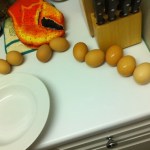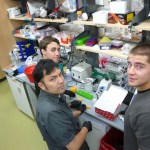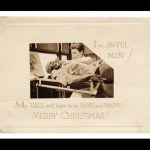lab
Science is cooking done in a lab. Mixing carefully (or not so carefully) measured components, heating, cooling, observing phase transitions, exploring the behavior of animal and plant proteins, exploring the properties of different chemicals, slowly changing variables to optimizing procedures. Often, feeding bacteria has a lot in common with feeding people, and I have to admit that freshly autoclaved yeast media smells delicious.
Said another way, cooking is science where at least you can usually eat the failures. My fiancé and I have been failing at making soft-boiled eggs for quite some…
This is so awesome - an arduino controlled fan cart.
If you are not familiar with the arduino, basically it is just a very simple and cheap programmable chip. I have been meaning to play around with one of these, but really I am afraid. Afraid I will like it just a little too much.
In this fan cart (made by Eric Ayars - who was at NC State when I was there), the arduino tells the fan when to turn on and off by sensing magnets on the track. Who cares? I care. This allows you to do some cool demos and activities with non-constant forces.
Some other things I can think of:
You could make…
The first (and sometimes 3rd, 12th, 25th, 134th...) step of any genetic engineering experiment is often extracting DNA from some organism or another. While novel gene synthesis technology will likely make this procedure obsolete, these days it's still most economical to do it by hand. Extracting DNA from fruits like strawberries has also seen a popular resurgence thanks to groups like DIYbio, with instructions for making DNA shots available online for a fun and nerdy party activity. Today my iGEM team extracted RNA from strawberries and oranges to isolate the genes responsible for strawberry…
So I had this great post planned about the Boston aquapocalypse but by the time I managed to get some water samples to the lab they had started heavily chlorinating the water and no bacteria were left! Since negative results don't make for good blog posts, please enjoy this video of my silkworms dancing to Flo Rida's Right Round instead.
Our temporary houseguest, Rusty, playing in a stream in northern New Jersey.
Here's my first little editing project for my documentary film class. A day in the lab, but much much faster paced.
Now I get to do something with that force scale I built.
I had a request some time ago to talk about friction. Friction is surprisingly complicated. When two surfaces rub against each other, why is there a friction force? The basic answer is that the stuff the two surfaces are made of (atoms) are interacting with each other. If you like, you could think of the bumps on one surface hitting the bumps on the other surface. I know I said it was complicated and that doesn't seem to complicated - does it? The complication comes when you try to model this interaction by looking at either all…
I was thinking about some experiments that deal with friction and I wanted to show something with a force probe. The problem is that most people don't have one of these. So, I decided to try and make one out of simple things. In this case, I am using some straws, a rubber band and some paper clips. Let me draw a little sketch of how this thing works.
The basic idea is to use the rubber band to measure the force (by measuring the amount the rubber band stretches). The two paper clips do two things. First, it allows you to hook up the device to something (like hanging some Lego bricks on…
What happens when your kids won't give you a turn on the Wii? Simple. You take their LEGO bricks and their slinky and do some physics. I will keep this simple. Basically, I created a slinky holder out of LEGO pieces and added LEGO bricks to the end to stretch it. Here is the video.
Lego + Slinky = Physics from Rhett Allain on Vimeo.
Maybe in an un-Dot Physics fashion, I am not going to analyze this data. I am not going to even describe the physics. Instead, I will leave this as a What Can You Do With This in the style of Dan Meyer.
I will give a couple of hints. First, I put this on…
Not really. Here are the details (and some data) for the Millikan Oil Drop Experiment without the oil drop that I talked about previously (originally from The Physics Teacher - lucky you, it was a featured article so it should still be available (pdf)).
The basic idea that Lowell McCann and Earl Blodgett from U of Wisconsin propose is to do an experiment similar to the oil drop experiment, but not so squinty (if you have done the oil drop experiment, you know what I mean). Instead of dropping charged oil in an electric field, they drop containers with metal nuts in water. The goal is to…
Sometimes it is difficult to come up with new labs. Ideally, a lab should show use some of the basic physics principles as well as have something the students can measure. What to do with circular motion? I don't know how I forgot this, but here is a lab I used to do as an undergraduate student. I also like it because it doesn't really need fancy stuff like PASCO probes or anything. The basic idea is that a small mass is swung around in a circle with the tension in the string controlled by hanging a mass on the other end. Here, let me show you.
Circular Motion Lab from Rhett Allain on…
My friend Konrad showed me this awesome toy he made.
I know it doesn't make sense yet, so let me explain. Basically, you take this marble and roll it down the tray through the pegs. The pegs sort of randomize where the marble rolls through the hidden section. Inside the hidden section, it looks like this:
The object of this toy is to find the cross-sectional area of the rings. Konrad said he built this based off of a toy he was given in middle school. He wasn't told how to do it, just to do it. Maybe I shouldn't say anymore about that toy except that it is awesome. No instructions,…
I don't really know what that title actually means. So, I have been having problems with my PASCO projectile launcher devices. I will just call them launchers (they are really cannons). In my previous post, I looked at the launch speed from a launcher shot horizontally and vertically. The problem was that I was getting different launch speeds for the vertical and horizontal shot. So, here is my plan: shoot the ball and a variety of angles from 0 to 90 degrees and see how the launch speed changes. I will only use the data from video analysis (of course using Tracker Video Analysis)…
The last time I looked at this projectile motion lab, I was confused. My different methods for measuring the launch speed of the ball were not even close to being consistent. So, I am bringing out the big guns - video. I made a video of the ball shot both horizontally off the table and vertically. No point posting the whole video (unless you really need it), but here is a screen shot of what the setup looked like.
These videos were made with my flip video camera, it doesn't have adjustable shutter speed so that there is some blur. Also, notice the carbon paper on the floor. This is so…
This is really a lab that I have students do, but I am pretty sure they don't read this blog - so it is ok. If they are reading this, hi!
We have these projectile cannons that shoot small balls. In order to look at projectile motion, they need to first determine the launch speed of the ball. I have a great method for this. Basically, shoot the ball horizontally off the table and measure how far horizontally it goes. You can get the final location of the ball by having it hit a piece of carbon paper on top of normal paper. If you don't know what carbon paper is, you are young.
Anyway,…
I found this in the most recent issue of The Physics Teacher (September 2009). Surprisingly, there were several good articles in this issue. One article discusses a doable version of the Millikan Oil drop experiment. Maybe you are not a (or were not) a physics major, so you might not be familiar with how cool, but tedious and squinty the oil drop experiment can be.
In the Millikan Oil drop experiment, small electrically charged drops of oil are placed in a constant electric field. It turns out that a small enough number of electrons are on each drop so that the quantization of charge can…
Note to self: don't do the mechanical equivalent of heat lab again. It doesn't really work that well and there are better labs to do.
So, what is the mechanical equivalent of heat lab? It is actually a pretty cool idea. Take and object and drop it. What happens to the kinetic energy the object had right before it hit the ground? Most of it goes into thermal energy of the object and surroundings. In this lab, the students measure the change in gravitational potential energy for a falling object (where object is really lead shot or something) and then measure the change in temperature in…
I was wondering around the blogosphere and read some stuff about introductory physics labs. In particular, I was looking at ZapperZ's Revamping Introductory Physics and Dr. Pion's Objectives for a Lab. Both of these are good posts. Here I thought I would add make take on this subject as I am picking the labs I will use for the summer session of introductory (algebra-based) physics labs.
When I first started teaching this lab, my goals for the course were a lot like Dr. Pions. Namely, I would like the students to improve in the following areas:
Critical thinking
Writing and communication…
I think the Mythbusters have a wonderful opportunity for educational outreach. Take this week's episode. One myth was to see if arrows fired from a moving horse penetrated more than arrows fired from a standing position. They first did this with real horses, but they said the data was not convincing.
I am pretty sure they had more than 10 trials recorded (there was a glimpse of the notebook). I would love to see this data and find (or let students find) the standard error of these measurements. This would be a great exercise to see how this whole uncertainty thing works.
As long as I am…
Christmas greeting card, school unknown, circa 1920.
Dittrick Medical History Center
from Dissection: Photographs of a Rite of Passage in American Medicine 1880-1930
Slate has an intriguing new review by Barron Lerner of a book called Dissection: Photographs of a Rite of Passage in American Medicine 1880-1930, by John Harley Warner and James M. Edmonson. The book delves into the turn-of-the-century practice of photographing medical students with cadavers - photos that today read as weird, grotesque, even offensive.
The photos unearthed by Warner and Edmonson depict an astonishing variety of…


